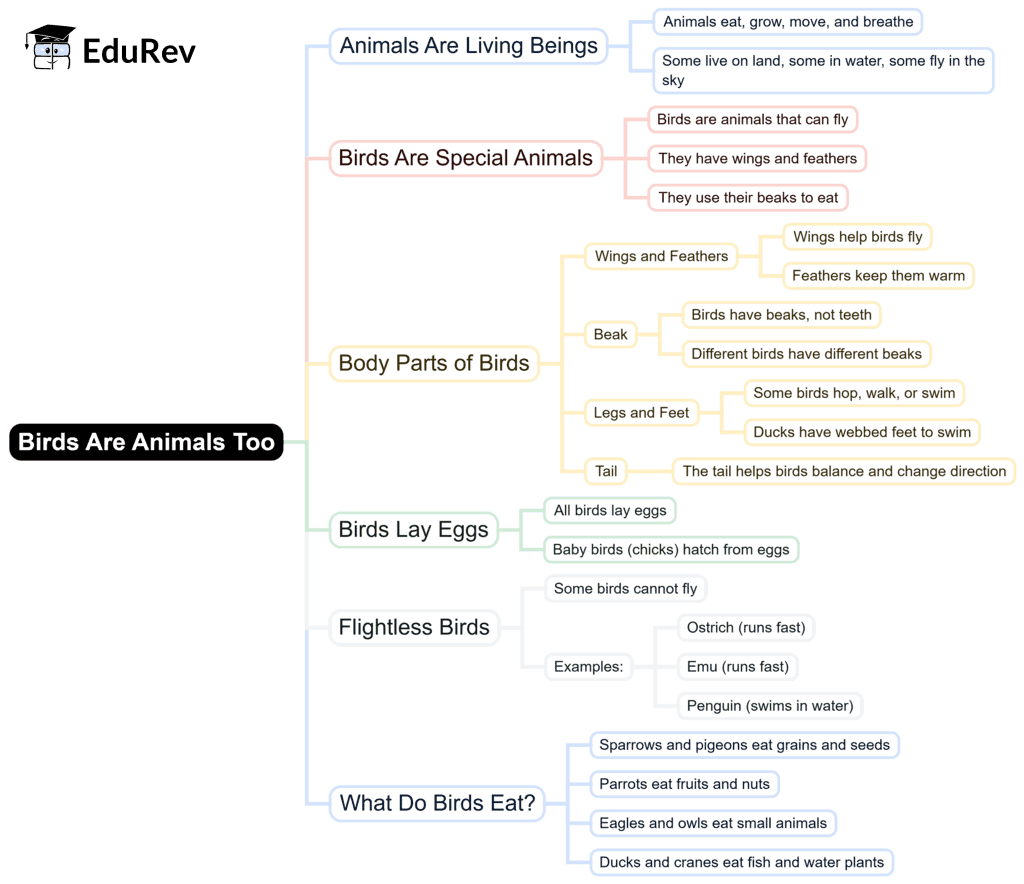Class 1 Exam > Class 1 Notes > EVS for Class 1 > Mind Map: Birds are Animals too
Mind Map: Birds are Animals too | EVS for Class 1 PDF Download

The document Mind Map: Birds are Animals too | EVS for Class 1 is a part of the Class 1 Course EVS for Class 1.
All you need of Class 1 at this link: Class 1
|
33 videos|215 docs|44 tests
|
FAQs on Mind Map: Birds are Animals too - EVS for Class 1
| 1. What are the key characteristics that classify birds as animals? |  |
Ans.Birds are classified as animals based on several key characteristics. They are part of the animal kingdom (Animalia) and share common traits with other animals, such as being multicellular, having eukaryotic cells, and being heterotrophic, meaning they cannot produce their own food and must consume other organisms. Birds also possess feathers, a beak without teeth, and lay hard-shelled eggs, distinguishing them from other animal groups.
| 2. How do birds differ from other types of animals? |  |
Ans.Birds differ from other types of animals primarily in their physiological and anatomical features. Unlike mammals and reptiles, birds have feathers that aid in flight and insulation. They also have a unique respiratory system that allows for efficient oxygen exchange during flight. Additionally, birds typically have a lightweight skeletal structure to facilitate flight, and their reproductive strategy involves laying eggs that are incubated outside of their bodies.
| 3. What role do birds play in the ecosystem? |  |
Ans.Birds play several crucial roles in ecosystems. They are important pollinators, helping to fertilize plants as they feed on nectar. Additionally, birds act as seed dispersers, aiding in plant reproduction and growth. They also contribute to pest control by feeding on insects and small animals, thus maintaining the balance of the ecosystem. Furthermore, birds serve as indicators of environmental health, as their presence or absence can signal changes in habitat quality.
| 4. What are some examples of different types of birds and their unique adaptations? |  |
Ans.Some examples of different types of birds include eagles, hummingbirds, and penguins, each adapted to their environments. Eagles have keen eyesight for hunting, while hummingbirds possess a specialized metabolism that allows them to hover and access nectar from flowers. Penguins, on the other hand, have adapted to aquatic life with streamlined bodies and flipper-like wings for swimming, showcasing the diversity of adaptations among bird species.
| 5. How have birds evolved over time? |  |
Ans.Birds have evolved over millions of years, with their ancestors believed to be theropod dinosaurs. The evolution of feathers is thought to have initially provided insulation and later facilitated flight. Fossil records indicate that modern birds began to diversify during the Cretaceous period, leading to the vast array of species we see today. This evolutionary journey reflects adaptations to various ecological niches and environmental changes, highlighting the dynamic nature of avian evolution.
Related Searches
















